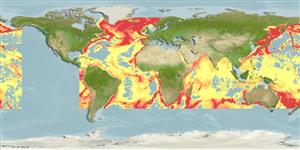Preferred temperature (Ref.
123201): 0.4 - 9.1, mean 3.4 °C (based on 3305 cells).
Phylogenetic diversity index (Ref.
82804): PD
50 = 0.5156 [Uniqueness, from 0.5 = low to 2.0 = high].
Bayesian length-weight: a=0.00059 (0.00030 - 0.00117), b=3.14 (2.96 - 3.32), in cm total length, based on LWR estimates for this species & (Sub)family-body (Ref.
93245).
Nivel trófico (Ref.
69278): 4.1 ±0.4 se; based on diet studies.
Resiliencia (Ref.
120179): Medio, población duplicada en un tiempo mínimo de 1.4-4.4 años (Assuming fecundity > 100).
Fishing Vulnerability (Ref.
59153): High vulnerability (60 of 100).
Nutrients (Ref.
124155): Calcium = 16.7 [9.7, 37.5] mg/100g; Iron = 0.412 [0.206, 0.836] mg/100g; Protein = 17.4 [15.1, 19.8] %; Omega3 = 0.376 [0.157, 1.018] g/100g; Selenium = 36.5 [15.4, 82.9] μg/100g; VitaminA = 9.95 [1.98, 51.99] μg/100g; Zinc = 0.27 [0.17, 0.41] mg/100g (wet weight);
